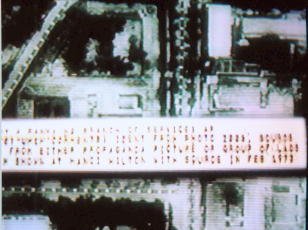
WHERE ARE OUR POWS? ... PAX Television 1/11/02
 |
|
WHERE ARE OUR POWS? ... PAX Television 1/11/02 |
 |
|
ORBACH: The men on board the ADLIB along with their gun ship disappeared into the void of POW politics. Has evidence been found that at least some of them are still alive? Is the Air Force anymore responsive to the evidence than the National Security Counsel, the White House, or the Pentagon? Of all the wars in which American soldiers have fought, none have left so much bitterness and anger on the conscience of the country than did the war in Vietnam. Even while it was in progress, the controversy threatened the nationís stability and today, nearly 30 years later, the specter of loved ones still imprisoned by a ruthless enemy and abandoned by our own seemingly indifferent government continues to tear at the fabric of America. Dr. Garth Fisher was in fifth grade when his fatherís gun ship , ADLIB, was struck by enemy fire and crashed. The next day The New York Times reported it as the biggest loss of the war so far. |
 |
| FISHER: Iíll never forget that morning. It was very early in the morning and my mother went to the door and there was my pastor there, as well as 2 servicemen from the Air Force and they told us that my father had been shot down the night before in Vietnam in his airplane and one of the servicemen had been, you know, rescued and that the other people they really knew nothing about, they were missing at this point. |
| ORBACH: The Fisher family accepted the Air Force determination that Major Donald Fisher had died when his gun ship crashed in Laos. Then, later in 1972, the family was watching the Evening News with Walter Cronkite when a story on the Vietnam War showed American POWs wandering through the jungle in Laos. |
 |
|
FISHER: : We were just sitting there eating when all of sudden my mother dropped her plate and said, "Thatís him, thatís him, thatís him!" We, you know, couldn't believe it, that there was this figure that you just couldn't see for that long but in that instant we all recognized as being our father and the next morning we were on the phone trying to get this clip back from CBS to bring it to our homes and that happened, they brought the clip to our home and showed it on a screen in our house and we were going reverse, backwards, forwards and we actually got some still photos off that film and we really felt strongly it was my father. When we did a lot of research and actually got in touch with the Air Force regarding this video and the stills that came from it, they told us that this was taken in 1969 and couldn't be my father because he was shot down in 1970. And, I remember we were very incensed because why would they show a film clip that was 3 years old? |
 |
| ORBACH: Why was the Air force so certain this was not Fisher? Did they know something about Major Donald Fisher they didn't want the family to know? |
 |
| FISHER: : When I got the information from the Freedom of Information Act, I was frankly shocked at all the things that I saw and read within their documents. What I found out was that the two fighter pilots who were following alongside my fatherís airplane were named Killer One and Killer Two, and they actually reported many parachutes coming out of the airplane which would communicate somebody was bailing out of that airplane. They also received contact with someone on the ground and his call sign was Ad Lib 12. All these men had secret call signs, my fatherís happened to be Ad Lib 12. And that person on the ground, Ad Lib 12, said that his hands and his face were burned, the enemy was closing in, they could no longer talk. |
| ORBACH: Doesn't this radio contact with Killer Two prove that Fisher was alive and about to fall into enemy hands? |
| FISHER: : The Air Force led us to believe that this was Sergeant Fields and he had made a mistake and had not reported his call sign correctly. |
| ORBACH: Now the question was did Sergeant Fields even make voice contact with Killer 2 the night of the crash? |
| FISHER: : What he told me was that he never had communication with anybody on the ground because the enemy was so close he couldn't have opened his mouth, he couldn't turn on his beeper, he couldn't do anything. And so, I was assured at that point that the Ad Lib 12 on the ground was not him, it was my father. |
|
ORBACH: Was the Air Force purposely hiding information from the night of the crash? If so, they were in real trouble. Another smoking gun destined to shoot down the official Air Force version of the ADLIB crash was just over the horizon. In November, 1987, Life Magazine published an article called, Looking for the Mysterious Mr. Rolle, complete with a photo of a POW called Rolle that was smuggled out of a POW camp in Laos. Charles Rowley, whose nickname was Rolle, was the navigator on the ADLIB gun ship. The Air Force official version of the Ad Lib crash was beginning to have holes in it. |

 |
 |
| JUDGE HAMILTON GAYDEN: The photograph that came from Laos, that we've referred to as the Rolle photograph, was sent to the three children of Lt. Colonel Charles Rowley, who was an MIA-POW. They all positively identified that as being their father. The picture then was sent to Dr. Michael Charnay, an expert, a forensic expert at Colorado State. Then Dr. Charnay concluded based upon the torso, the hands, the head and all the body parts that it was the same person. |
| ORBACH: But similarities are not positive ID and other family members, as well as the government, had reservations. The governmentís official policy of insisting there are no live POWs may have motivated their rejection of the photo but why would the family object? |
 |
|
PATTI SAYLES: Actually some of the family members did hesitate to identify the photo as my father. They needed to maintain their level of closure. I wanted to find out the truth. My experience in the past with the Air Force was that I was not getting total honesty. In 1976, my brother and I attended a court hearing to have my fatherís status changed from missing in action to killed in action. There were 10 individual court hearings for each of the ADLIB crew members. Right before the hearing, we were allowed for the first time, to see my fatherís Air Force files. In those files there was one particular sentence that caught my eye. A source recognized a face from either a propaganda picture or a group of Laos PWS, meaning prisoners of war, viewing film shown at the infamous POW camp the Hanoi Hilton. |
 |
| Therefore, that meant that my father had survived the ADLIB crash. So during the hearing, my brother and I asked to see the photo. We were unable to because it was classified. We found that the officials at the hearing who were making the decision were also unable to see classified information. We were told that if we continued to press the issue we would be in contempt of court. My brother and I ignored the warning and we were asked to leave. |
| ORBACH: In 1993, the U.S. government conducted a joint US-Laos crash site excavation of a AC130A Spectre gun ship. What they found were a few teeth and some bone chips. Amazingly, the government accepted this as the successful recovery of the remains of all 10 missing crewmen. |
 |
| O'SHEA: This is a great example of what we call creative accounting by the Defense Department where they will take minimal remains and bury an entire crew of 10 or 12 men. |
 |
| ORBACH: The ADLIB excavation and remains recovery effort did not sit well with members of the ADLIB crew families. Some of them have what they consider to be solid evidence that their loved ones had, in fact, survived. |
 |
| PATTI SAYLES: The casualty officer came to my home after having gone to the excavation site. I didnít believe everything he was telling me, especially when he handed me a pristine dog tag with my fatherís name on it. Now, keep in mind, this dog tag had been through a huge fire and an airplane crash, had been in the jungle for 23 years and it was still in pristine condition. And remarkably, they found all the dog tags for the other 9 missing crew members. |
| ORBACH: But even as one POW issue lurches toward a resolution, other long silent mysteries remain. Did the Soviets secretly transport American POWs to the former Soviet Union, from North Korea and Southeast Asia? And even from German POW camps in World War II. And is it possible that Americans ended up in Soviet slave labor camps, many in even more horrific circumstances as guinea pigs for Soviet run medical experiments? |
| NEXT SEGMENT |